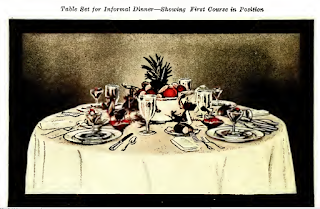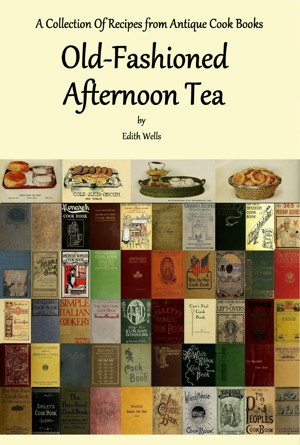1922 Luncheon Menu: Bouillon, Lobster Chops with Tomato Sauce, Breast of Grouse, Bavarian Cream
Woman's World Cookbook (1922)
1922 Luncheon Menu
Miss Corson's Practical American Cookery and Household Management (1885)Bouillon.
Lobster Chops with Tomato Sauce.
Cucumbers. Olives. Radishes. Crackers and Cheese.
Mayonnaise of Chicken. Vol-au-vent of Oysters.
Breast of Grouse broiled, with Orange Salad.
Lettuce Salad. Roquefort Cheese. Toasted Crackers.
Bavarian Cream. Noyeau Jelly. Tutti Frutti.
Chocolate. Fruit. Bonbons.
LOBSTER CHOPS OR CUTLETS.
1 lobster
2 tbs butter
2 tbs flour
½ pint milk or cream
Salt
Cayenne
2 egg yolks
1 glass sherry or Madeira
Cracker dust
2 whole eggs, beaten
Fat to fry
Parsley for garnish
Kull a lobster; remove the meat, and cut it in small, even dice; save the coral and green fat in opening the lobster; put in a thick saucepan over the fire two tablespoonfuls each of butter and flour, and stir them until they bubble; then gradually stir in half a pint of milk or cream; add the lobster, together with the coral and fat, and a rather high seasoning of salt and cayenne; stir the mixture constantly until it is very hot; then take it from the fire, and stir in the yolks of two raw eggs, and a glass of sherry or Madeira; put the mixture into a dish to cool. When it is cold, make it up in the form of small chops or cutlets, shaping them with the hands wet in cold water; as the chops are made, lay them in a platter containing plenty of cracker-dust; put over the fire a frying-kettle half full of fat to heat; beat two eggs smooth; dip the chops into the egg, and then lay them again in the cracker-dust. When the fat begins to smoke, put the chops into it, and fry them golden brown; when the chops are brown, take them out of the hot fat with a skimmer, lay them on brown paper for a moment to free them from grease, put a small lobster-claw in each one, and then serve them garnished with parsley.
CHICKEN SALAD.
1 pint cold boiled or roasted chicken
1 large head of lettuce or celery
1 cupful of mayonnaise
Salt and pepper
Oil
Vinegar
Hard-boiled eggs, cold boiled beets, capers, olives, lettuce leaves, or celery leaves for garnish
A good salad can be made from cold boiled or roasted chicken, cut in small pieces; for a pint of chicken allow a large head of lettuce, thoroughly washed and torn in pieces, and a cupful of mayonnaise. To make the mayonnaise, put into an earthen bowl the yolk of a raw egg, a level teaspoon-ful of salt, a teaspoonful of vinegar, and a little pepper; stir these ingredients until they are smoothly mixed, and then gradually drop in a cupful of good salad-oil, adding it slowly, and stirring the mayonnaise constantly until it grows quite thick; then use a few drops of vinegar to thin it a little, and after that stir in more oil; proceed in this way until all the oil is use ; when ready to serve the salad, mix the lettuce and chicken in a salad-bowl, season them lightly with salt, pepper, oil, and vinegar, pour the mayonnaise over the salad, and serve it at once. Chicken salad is sometimes made with celery instead of lettuce, and is usually garnished with hard-boiled eggs cold boiled beets, capers, olives, and the small leaves of lettuce or celery are also used to garnish chicken salad.
RAGOUT OF OYSTERS FOR VOL-AU-VENT.
1 quart large oysters
2 tbs flour
2 tbs butter
Oyster-liquor
Cream or milk (if needed)
Salt and pepper
A little grated nutmeg
Yolks of 2 raw eggs (optional)
3 tbs oil (optional)
1 tbs lemon-juice (optional)
Pastry cases to fill
Carefully remove all particles of shell from a quart of large oysters, and strain their liquor to free it from sand and shell; put into a thick saucepan two tablespoonfuls each of flour and butter, and stir them over the fire until they begin to bubble; then gradually stir in enough of the oyster-liquor to make a sauce thick enough to coat the spoon, or as thick as thick cream. If there is not enough oyster-liquor, use some cream or milk to make up the required quantity; season the sauce palatably with salt, pepper, and a very little grated nutmeg, and let it boil once; then put in the oysters, and stir them in the sauce until their edges curl. The ragout may be used in that condition, or the yolks of two raw eggs may be stirred into it after it is taken from the fire, and three tablespoonfuls of oil and one of lemon-juice added, a few drops at a time. While the oysters are being cooked, the vol-au-vent case may be heated in the oven, if it is wanted hot. To prepare it for the ragout, use a sharp knife to cut around and lift up the cover; take out from the middle of the case all the soft, heavy part of the pastry, and then fill it with the ragout; as soon as the case is filled, lay the cover over it, and serve it at once. If the ragoût stand in the case, the latter becomes saturated, and loses its fresh, crisp character. When the vol-au-vent is to be served cold, let the ragout cool before putting it into the case.
PRAIRIE CHICKENS BROILED.
Grouse
Butter
Salt and pepper
Pluck and singe the birds, wipe them with a wet towel, split them down the back, draw them, and place them between the bars of a buttered double wire gridiron. First expose the inside to the fire until it begins to brown; turn the breast to the fire, and slightly brown it; next rub a little butter all over the bird, season it with salt and pepper, and broil it quite brown on the inside, cooking it at least ten minutes; then finish browning the breast quickly. Serve the prairie-chicken hot, on a hot dish, with a tablespoonful of butter laid over it as soon as it is dished, and send it at once to the table.
ORANGE SALAD
Thinly sliced oranges
Salt
Cayenne
1 tbs lemon-juice
3 tbs oil
The fruits which we are accustomed to associate with breakfast or dessert may be used as salads: the only point to be remembered is that they must be of a pronounced flavor or acid. Orange salad, made of thinly sliced oranges, freed from seeds, and dressed with salt, cayenne, lemon-juice, and oil, one tablespoonful of lemon-juice to three of oil, is a delicious accompaniment for broiled or roasted game or poultry.
BAVARIAN CREAM.
¼ ounce gelatin
1 gill hot water
1 egg white
4 ounces pulverized sugar
5 drops lemon
10 drops vanilla essence
1 tbs brandy
1 pint whipped cream
Yolk of 1 raw egg
Sponge cake or lady-fingers
This cream is served cold in a form, or sometimes replaces whipped cream in a charlotte-russe. To make it, put a quarter of an ounce of gelatine over the fire with a gill of hot water, and stir the gelatine until it is dissolved, when it may be set near enough to the fire to keep it liquid; whip the white of one egg to a stiff froth, and gradually pour the liquid gelatine into it, whipping it until it begins to set; then cool it for five minutes; whip it again, and stir into it four ounces of pulverized sugar, five drops of lemon and ten of vanilla essence, and a tablespoonful of brandy; meantime, prepare a pint of whipped cream; when the whipped cream is ready, beat the yolk of one raw egg for one minute, and then beat it into the prepared gelatine; last of all, add the pint of whipped cream, stirring it in very gently and thoroughly, and use the cream to fill a charlotte-mould lined with sponge-cake or lady-fingers. The Bavarian cream is sometimes cooled in a mould, and turned out on a base of whipped cream.
NOYEAU JELLY.
1 ounce isinglass
½ pint lukewarm water
1 lb loaf-sugar
Juice of ½ a lemon
½ a pint of cold water
1 wineglass noyeau cordial or liqueur
Put an ounce of the best isinglass into half a pint of lukewarm water, and stir it over the fire until it is dissolved meantime put over the fire a pound of loaf-sugar, the juice of half a lemon, and half a pint of cold water, and boil them without stirring until they form a thick sirup; mix with the dissolved isinglass the sirup and a wineglass of noyeau cordial or liqueur; and then strain the jelly into a mould wet in cold water, and allow the jelly to harden before turning it out of the mould.
TUTTI FRUTTI ICING.
Boiled Icing (see below)
1 ounce chopped citron
1 ounce candied cherries
1 ounce seedless raisins
1 ounce candied pineapple
1 ounce blanched almonds
Mix with a boiled icing made as directed below, one ounce each of chopped citron, candied cherries, seedless raisins, candied pineapple, and blanched almonds.
BOILED ICING.
5 ounces white sugar
1 gill cold water
1 egg white
Put five ounces of white sugar over the fire in a sugar- boiler, with a gill of cold water, and boil it until it is thick enough to drop in fine threads from the spoon, from which a little is poured; while the sugar is thus being boiled to a thread, beat the white of one egg to a stiff froth, and when the sugar is ready pour it gradually into the egg, beating all the time, until the icing is white and smooth; then apply it to the cake.
ALMOND CAKE.
1 lb of flour
Powdered sugar to dust mould
6 ounces or 1 cupful butter
½ lb of powdered sugar
1 tbs rosewater
12 egg whites
Another ½ lb powdered sugar
Sift a pound of flour, and put it near the fire to dry; line two medium-size cake-moulds with buttered paper, or butter the moulds thickly, and dust them with powdered sugar; and see that the oven is properly heated. Beat six ounces or a cupful of butter to a cream, with half a pound of powdered sugar; add a tablespoonful of rosewater, and then gradually beat in the flour; beat the whites of twelve eggs to a stiff froth, and lightly mix half a pound of powdered sugar with them; then mix the whites with the cake-batter, working very quickly and lightly; put the batter into the moulds, set the moulds on earthen plates, and bake the cakes in a moderate oven for about three-quarters of an hour, or until a clean broom-straw can be thrust into them and withdrawn without being sticky.




Comments
Post a Comment